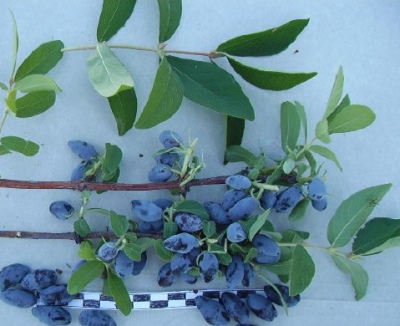
- Authors: Vladimir Sergeevich Ilyin, Ilyina Nina Alekseevna
- Year of approval: 1999
- Growth type: medium-sized
- Description of the bush: compact
- Bush height, m: 1,7-1,8
- Escapes: medium, curved, pubescent, matte
- Leaves: large, dark green, slightly pubescent
- Crown: thick
- Flowers: large, pale-colored
- Fruit size: large
Edible honeysuckle is gaining immense popularity among summer residents and farmers. This is due to the fact that the berry is very healthy, ideal for processing and easy to grow. The Lazurite variety, which is able to cultivate and bear fruit in different climatic conditions, is considered especially in demand.
Breeding history
Lapis lazuli is a mid-season variety created in the South Ural Research Institute of Fruit and Vegetable and Potato Growing by free pollination of Smolinskaya seedlings. The authorship belongs to Russian scientists-breeders N. A. Ilyina and V. S. Ilyin. It is recommended to grow a berry crop in all regions of Russia. Honeysuckle has been listed in the State Register of Approved Use since 1999.
Description of the variety
Lapis lazuli is a medium-sized shrub that grows in a favorable environment up to 170-200 cm in height. The plant is characterized by a compact, rounded crown with a strong thickening of dark green leaves. A feature of the bushes are curved stems with an ideal surface smoothness and increased foliage wrinkling.
Shrubs bloom in the first half of May. At this time, the bush becomes decorative and attractive, since it is densely covered with large light pink flowers that emit a sweetish aroma.
Fruit characteristics
Mid-season honeysuckle belongs to the class of large-fruited species. An adult shrub ripens berries weighing up to 2.5 grams. The shape of the berries is classic - cylindrical with a neat sharpened edge. At the stage of technical maturity, the fruits are covered with a light, yellow-green color. Ripe fruits are evenly covered with dark blue or deep purple color with a thick bluish bloom. The skin of the berries is thin, slightly bumpy. The berries stick to shortened stalks, partially crumbling in strong winds, and when they are overripe. Harvesting is easy - by simply shaking the branches.
The purpose of this variety of honeysuckle is universal - it is eaten fresh, processed into fruit drinks, jams, compotes, and frozen. Due to the fact that the berries are very delicate and fragile, they must be transported very carefully, and their keeping quality is weak - for several days in a cool place.
Taste qualities
Lapis lazuli has excellent taste. The pulp of the fruit is tender, fleshy, juicy. The taste is balanced - summer sweetness, complemented by a pleasant piquant sourness and dessert aroma, which is not very pronounced. Sometimes a slight sweetness is felt in the taste. The pulp contains a high content of ascorbic acid, organic acids, as well as magnesium, phosphorus, iron and potassium.
Ripening and fruiting
Lapis lazuli is a mid-season variety. The bush begins to bear fruit in the 3-4th year after planting. The berries ripen gradually, so the harvest is harvested in several stages. Mass ripening occurs from late June to mid-July. The dates can be shifted under the influence of the vagaries of the climate.
Yield
The yield of the variety is average. By caring for the shrub, you can get a good harvest of useful berries. On average, about 1.5 kg of berries can be harvested from 1 bush. The maximum indicator reaches 2.3 kg.

Self-fertility and the need for pollinators
Honeysuckle Lapis lazuli, like most of its relatives, is self-fertile. That is why it is recommended to plant pollinating varieties on the site that bloom simultaneously with Lapis Lazuli. The most productive pollinating shrubs are considered: Fire opal, Cubic zirconia, Vlada.
Growing and care
Planting of a two / three-year-old seedling is carried out in the fall - September-October. They are planted, as a rule, in the southern part, at a distance of 2-2.5 meters from other plantings. The agricultural technology of the variety consists of regular watering, the introduction of organic matter and complex fertilizers from the third year of life, crown molding, branch pruning, disease prevention, loosening and weeding of the soil.


Disease and pest resistance
Lapis lazuli is highly resistant to many fungal and bacterial infections, therefore it rarely undergoes powdery mildew, septoria and rust. Sometimes the bushes are attacked by aphids, leafworms, scale insects, spraying with insecticides will help get rid of them.

Winter hardiness and the need for shelter
Lapis lazuli is characterized by excellent frost resistance, therefore it easily tolerates temperature drops down to –30 ... 34 degrees. It should also be noted that the plant is not afraid of spring return frosts. Due to their high winter hardiness, the bushes do not need to be wrapped up for the winter.
Location and soil requirements
This berry culture is very fond of warmth, light, air, therefore, it is planted in an area well-lit by the sun's rays, while being reliably protected from cold winds and drafts. The optimum will be a site where there is no stagnation of moisture, and the flow of groundwater is deep enough. Nourishing, breathable, moisture-permeable and fluffy soil with a neutral acidity will become comfortable for growing.
































































